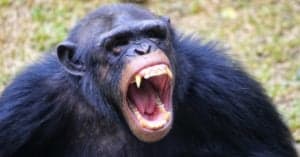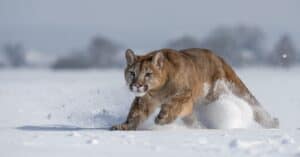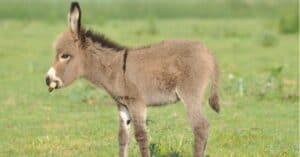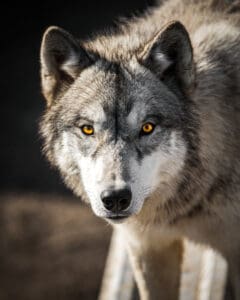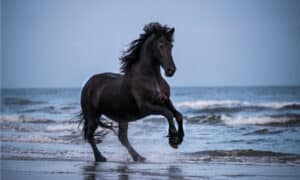European Bison vs American Bison: 4 Key Differences Explained
@media (min-width: 481px) {
.mobile-top-content {
display: none;
}
}
#mobileTopContentCTACarouselControls { overflow: hidden; text-overflow: ellipsis; white-space: nowrap; }
.mobile-top-content .more { color: #fff; }
.mobile-top-content a { color: #fff; text-decoration: underline; }
.mobile-top-content a:hover { color: #fff; text-decoration: underline; }
@media (max-width: 480px) {
.mobile-top-content {
background-color: #06a10b;
color: #fff;
text-align: center;
/*height: 60px;
padding-top:5px;*/
font-size:80%;
/* display: block; */
margin: 0px -30px;
}
}
Bison are large herbivorous mammals that are native to places such as North America and parts of Europe where they live predominantly in grasslands. They live in herds and are characterized by their large, heavy bodies, humped shoulders, small horns, and unpredictable natures. There are two species of bison – European and American – and they are incredibly similar to each other. However, despite their similarities, there are quite a lot of differences between them, with some more subtle than others. So join us as we discover all of the key differences between European bison and American bison.
Comparing American Bison vs European Bison
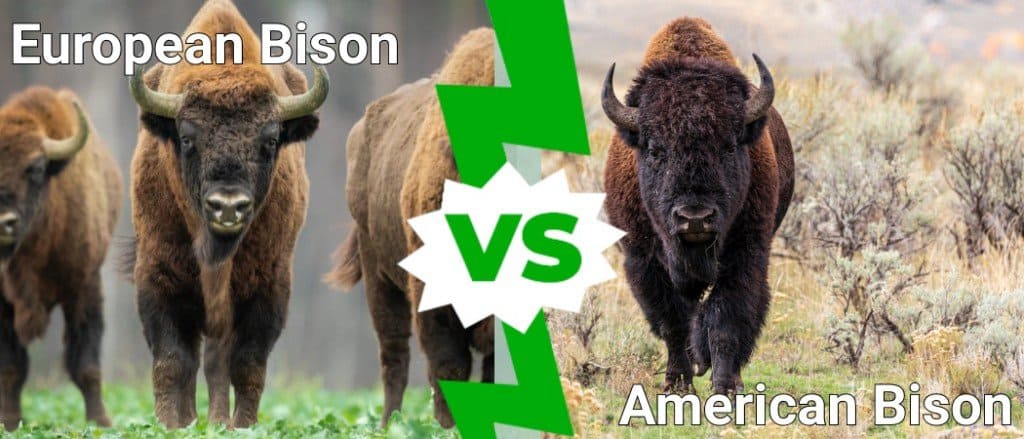
A-Z-Animals.com
European bison (Bison bonasus) are the largest and heaviest land mammal in Europe. There were formerly three subspecies, although only one (Bison bonasus bonasus) remains – the other two are now extinct.
American bison (Bison bison) are the heaviest and longest animal in North America, but the second tallest after moose. There are two subspecies of American bison – plains bison and wood bison. Wood bison are generally the larger of the two and have a larger, more square hump. However, getting back to the differences between American and European bison, there are some significant differences between them which make it easier to tell the two apart.
Check out the chart below to learn a few of the main differences.
| American Bison | European Bison | |
| Location | US, Canada, Mexico, Russia | Belarus, Germany, Lithuania, Poland, Switzerland |
| Habitat | Grassland, scrubland, river valleys | Grassland, deciduous and mixed forests |
| Size | Weight – 700 to 2,180 pounds Height – 6ft 1in to 6ft 7in at the shoulder |
Weight – 935 to 2,030 pounds Height – 5ft 9in to 6ft 9in at the shoulder |
| Ribs | 15 | 14 |
| Lumbar Vertebrae | 4 | 5 |
| Diet | Grazers | Browsers |
| Horns | Point more sideways and upwards | Point more forwards |
| Hair | Body – more hairy than European Tail – less hairy |
Body – less hairy than American Tail – more hairy |
| Nose | Further back than forehead | Further forward than forehead |
| Head / Neck | Naturally hands lower than European | Naturally hands higher than American |
| Fighting | Butting and charging | Interlock horns |
| Tameability | Easier to tame (also easier to breed with cattle) | Difficult |
| Predators | Wolves, grizzly bears | Humans, wolves, bears |
The 4 Key Differences Between European Bison and American Bison
The key differences between European and American bison include size, appearance, bone structure, and horns. American bison are generally larger and have an appearance that’s geared toward grazing while European bison browse. Also, the two species of bison have different numbers of ribs and lumbar vertebrae. Let’s dig into the main differences in more detail below.
European Bison vs American Bison: Size

One of the main differences between European and American bison is their size difference. However, they are quite unique as American bison are the heavier of the two, while European bison are the taller of the two. American bison weigh between 700 and 2,180 pounds, with the males being heavier than females. They stand between 6ft 1ins and 6ft 7ins. European bison weight between 935 and 2,030 pounds, again with the males being the heaviest. Their height ranges between 5ft 9in and 6ft 9in at the shoulder. The reason European bison tend to be taller than their American counterparts is because they have longer legs.
European Bison vs American Bison: Appearance
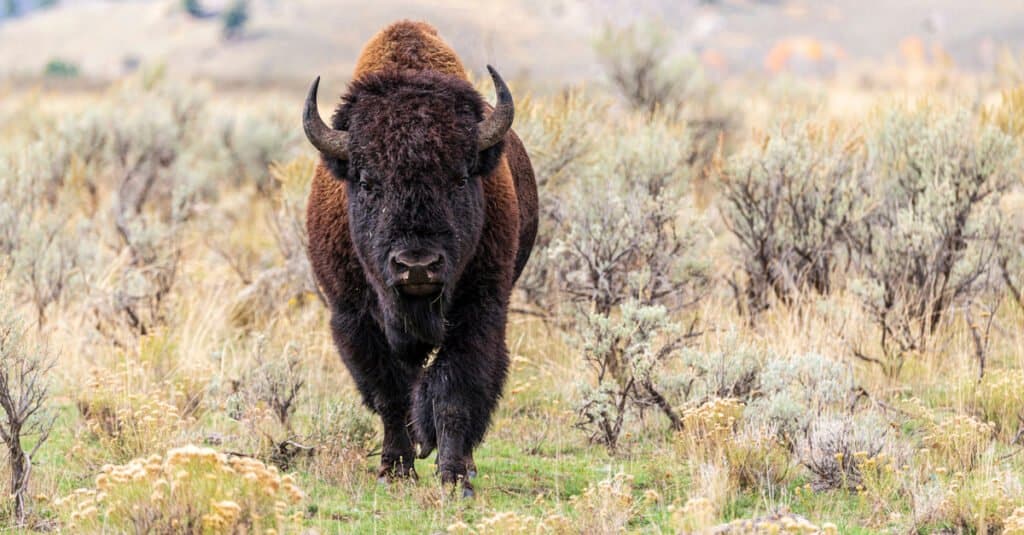
Grey Mountain Photo/Shutterstock.com
There are several differences in the appearance and stance of European and American bison which set them apart. For a start, American bison have a much hairier body than European bison, but their tail is less hairy. The shape of their faces are different too as the nose of American bison sits further back than the forehead when the head is in a neutral position. The opposite is true for European bison, whose nose is further forward than their forehead.
European and American bison also hold their heads differently, and this has an effect on their diet. European bison naturally hold their head and neck higher than American bison, and they are browsers rather than grazers. On the other hand, American bison hold their head and neck lower than European bison. This suits their diet as they are grazers rather than browsers.
European Bison vs American Bison: Horns
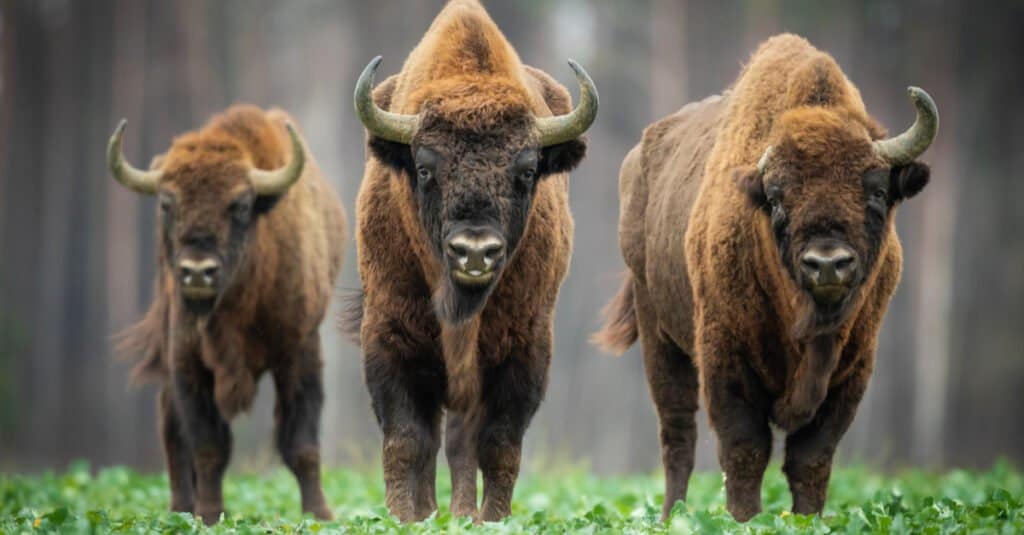
Szczepan Klejbuk/Shutterstock.com
Another distinctive difference between American and European bison is their horns. The horns of the European bison point more forwards than those of the American bison which point more sideways and upwards. The way that their horns point aids them in their favored method of fighting. European bison generally fight by locking horns, and their forward-pointing horns favor this. However, American bison prefer to fight by butting and charging.
European Bison vs American Bison: Bones

Although it’s not a visual difference between the two, European and American bison have different numbers of ribs and lumbar vertebrae. American bison have fifteen pairs of ribs while European bison only have fourteen. Additionally, European bison have five lumbar vertebrae while American bison only have four. In the case of the lumbar vertebrae, this difference is because in the American bison the first lumbar vertebrae has ribs attached to it. This means that it is counted as an extrathoracic vertebrae instead of a lumbar vertebrate.
FAQs (Frequently Asked Questions)
Can European and American bison cross breed?
Yes, European and American bison can cross breed, producing hybrid offspring.
How close did bison come to extinction?
Both American and European bison came extremely close to extinction – with European bison actually becoming extinct in the wild in the early twentieth century. However, thanks to captive breeding programs they have recovered, although they no longer exist in many of the areas that they had previously roamed. Additionally, through a combination of hunting and disease, there were only 541 American bison left in 1889, but the species has gradually recovered through a number of reintroductions. However, although numbers are far better nowadays, both American and European bison are still officially classed as near threatened.
Are bison dangerous to humans?
Yes, bison can be extremely dangerous animals and are known to attack and charge at people even when unprovoked. Despite their bulk, they can move incredibly fast and can easily outrun us humans. In North America, American bison are some of the most dangerous animals in the national parks and often injure more people than bears.
Can bison cross breed with cattle?
Although all bison are large, unpredictable animals, American bison are generally easier to tame than European bison. Due to their slightly better nature, they are also easier to crossbreed with cattle. For a while, cross-breeding American bison bulls with female cattle was popular across ranches in the US. However, as the resulting offspring didn’t show enough signs of hybrid vigor (desirable traits from both parents), the practice has largely stopped. European cattle have also crossbred with cattle at times, but again, the practice has now mostly been abolished.
More from A-Z Animals
.more-snake-card-image { max-height:140px !important; }
@media (min-width: 481px) {
.mobile-top-content {
display: none;
}
}
#mobileTopContentCTACarouselControls { overflow: hidden; text-overflow: ellipsis; white-space: nowrap; }
.mobile-top-content .more { color: #fff; }
.mobile-top-content a { color: #fff; text-decoration: underline; }
.mobile-top-content a:hover { color: #fff; text-decoration: underline; }
@media (max-width: 480px) {
.mobile-top-content {
background-color: #06a10b;
color: #fff;
text-align: center;
/*height: 60px;
padding-top:5px;*/
font-size:80%;
/* display: block; */
margin: 0px -30px;
}
}
Bison are large herbivorous mammals that are native to places such as North America and parts of Europe where they live predominantly in grasslands. They live in herds and are characterized by their large, heavy bodies, humped shoulders, small horns, and unpredictable natures. There are two species of bison – European and American – and they are incredibly similar to each other. However, despite their similarities, there are quite a lot of differences between them, with some more subtle than others. So join us as we discover all of the key differences between European bison and American bison.
Comparing American Bison vs European Bison

A-Z-Animals.com
European bison (Bison bonasus) are the largest and heaviest land mammal in Europe. There were formerly three subspecies, although only one (Bison bonasus bonasus) remains – the other two are now extinct.
American bison (Bison bison) are the heaviest and longest animal in North America, but the second tallest after moose. There are two subspecies of American bison – plains bison and wood bison. Wood bison are generally the larger of the two and have a larger, more square hump. However, getting back to the differences between American and European bison, there are some significant differences between them which make it easier to tell the two apart.
Check out the chart below to learn a few of the main differences.
| American Bison | European Bison | |
| Location | US, Canada, Mexico, Russia | Belarus, Germany, Lithuania, Poland, Switzerland |
| Habitat | Grassland, scrubland, river valleys | Grassland, deciduous and mixed forests |
| Size | Weight – 700 to 2,180 pounds Height – 6ft 1in to 6ft 7in at the shoulder |
Weight – 935 to 2,030 pounds Height – 5ft 9in to 6ft 9in at the shoulder |
| Ribs | 15 | 14 |
| Lumbar Vertebrae | 4 | 5 |
| Diet | Grazers | Browsers |
| Horns | Point more sideways and upwards | Point more forwards |
| Hair | Body – more hairy than European Tail – less hairy |
Body – less hairy than American Tail – more hairy |
| Nose | Further back than forehead | Further forward than forehead |
| Head / Neck | Naturally hands lower than European | Naturally hands higher than American |
| Fighting | Butting and charging | Interlock horns |
| Tameability | Easier to tame (also easier to breed with cattle) | Difficult |
| Predators | Wolves, grizzly bears | Humans, wolves, bears |
The 4 Key Differences Between European Bison and American Bison
The key differences between European and American bison include size, appearance, bone structure, and horns. American bison are generally larger and have an appearance that’s geared toward grazing while European bison browse. Also, the two species of bison have different numbers of ribs and lumbar vertebrae. Let’s dig into the main differences in more detail below.
European Bison vs American Bison: Size

One of the main differences between European and American bison is their size difference. However, they are quite unique as American bison are the heavier of the two, while European bison are the taller of the two. American bison weigh between 700 and 2,180 pounds, with the males being heavier than females. They stand between 6ft 1ins and 6ft 7ins. European bison weight between 935 and 2,030 pounds, again with the males being the heaviest. Their height ranges between 5ft 9in and 6ft 9in at the shoulder. The reason European bison tend to be taller than their American counterparts is because they have longer legs.
European Bison vs American Bison: Appearance

Grey Mountain Photo/Shutterstock.com
There are several differences in the appearance and stance of European and American bison which set them apart. For a start, American bison have a much hairier body than European bison, but their tail is less hairy. The shape of their faces are different too as the nose of American bison sits further back than the forehead when the head is in a neutral position. The opposite is true for European bison, whose nose is further forward than their forehead.
European and American bison also hold their heads differently, and this has an effect on their diet. European bison naturally hold their head and neck higher than American bison, and they are browsers rather than grazers. On the other hand, American bison hold their head and neck lower than European bison. This suits their diet as they are grazers rather than browsers.
European Bison vs American Bison: Horns

Szczepan Klejbuk/Shutterstock.com
Another distinctive difference between American and European bison is their horns. The horns of the European bison point more forwards than those of the American bison which point more sideways and upwards. The way that their horns point aids them in their favored method of fighting. European bison generally fight by locking horns, and their forward-pointing horns favor this. However, American bison prefer to fight by butting and charging.
European Bison vs American Bison: Bones

Although it’s not a visual difference between the two, European and American bison have different numbers of ribs and lumbar vertebrae. American bison have fifteen pairs of ribs while European bison only have fourteen. Additionally, European bison have five lumbar vertebrae while American bison only have four. In the case of the lumbar vertebrae, this difference is because in the American bison the first lumbar vertebrae has ribs attached to it. This means that it is counted as an extrathoracic vertebrae instead of a lumbar vertebrate.




